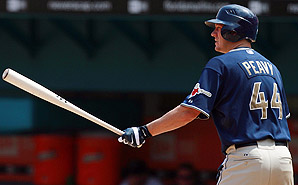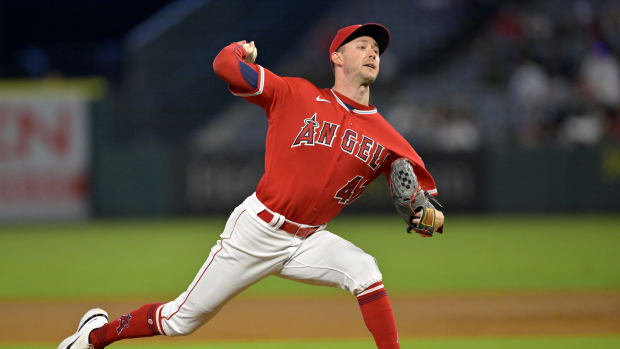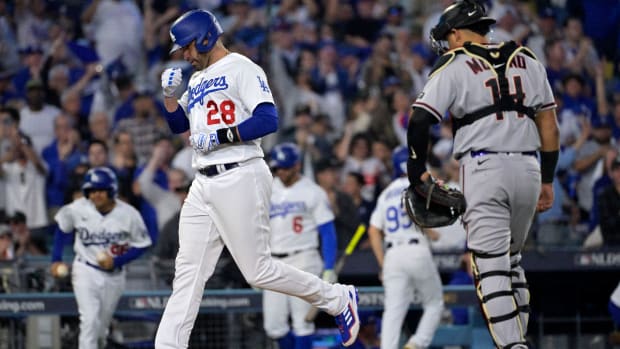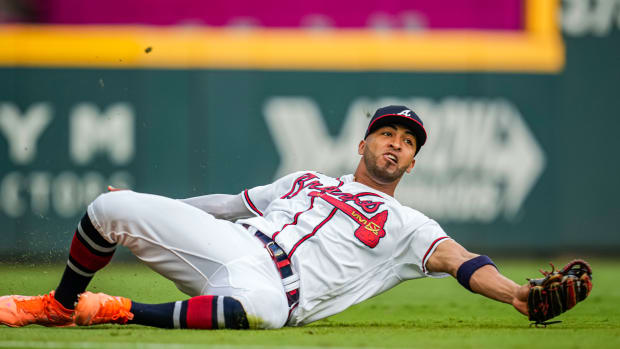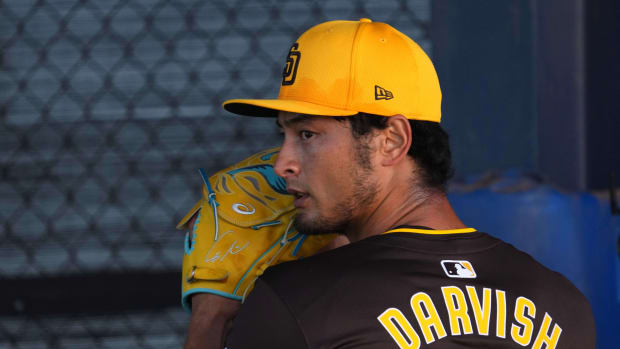Unconventional Wisdom: Who are today's best-hitting pitchers?
Still, if you aren't accounting for pitcher hitting, you're unambiguously cheating some players out of their value. For example, Micah Owings had a VORP of 16.5 last season, so his offense did more to contribute to his team's success than real-life hitters such as J.D. Drew, Ivan Rodriguez and Rafael Furcal. But how much of that performance was actual skill rather than a fluke of small sample size? Pitcher hitting suffers from the monkeys-typing-Shakespeare problem: Take enough pitchers, give them all 70 at-bats or so, and two or three of them are going to wind up hitting .320 with a couple of long balls, perhaps simply by a stroke of luck.
To address this question, I developed a regression-based system for projecting hitter performance that I'll call SPHPS (Simple Pitcher Hitting Projection System), which isn't a catchy anagram at all, but has the virtue of being a palindrome. This system is derived solely from the hitting statistics of pitchers; you don't want to include position players in the same dataset because then you'll regress toward the mean established by position players, when pitchers and position players are selected to play in the major leagues based on totally different skill sets. (The gap between pitcher and position-player hitting has grown steadily since the dawn of baseball time).
Without going into too much more detail about SPHPS, which isn't anything terribly sophisticated, here are a couple of tips to keep in mind when you're trying to find good-hitting pitchers:
Ignore batting average. Batting averages take long enough to stabilize, even when you have a full 600 or 700 plate appearances to work with. With pitchers you'll be lucky to get one-tenth that many, and there just isn't any hope for the same sort of stability in batting averages. Instead, focus on a pitcher's strikeout rate. If a pitcher can make some kind of contact, more often than not he's eventually going to leg out a couple of base hits.
In addition to strikeout rate the other big category to focus on is extra-base hits, and particularly home runs. As long as you're putting wood on the ball you're going to back into a base hit now and then, but getting an extra-base hit will usually require some kind of actual hitting skill.
The younger the pitcher the better. Pitcher hitting does not appear to peak at age 27, as you might see for a hitter. Instead it just gets worse the older a pitcher gets. This is undoubtedly because pitchers don't spend a lot of time working on their hitting once they turn pro, so there's nothing to compensate for the decline in raw athletic skill.
Athleticism helps. Being bigger and stronger is a positive indicator, and if a pitcher runs pretty well that's usually a good sign too.
The balance of this article will be devoted to identifying the 10 best-hitting pitchers in baseball as identified by SPHPS. The specific measure we use is the number of extra runs a pitcher produces relative to a league-average hitting pitcher, as derived from a version of the Marginal Lineup Value formula and assuming that the pitcher gets 80 plate appearances in a season -- roughly the number of plate appearances a pitcher should expect if he spends the whole year in the rotation and makes 32 or 33 starts). Minor league statistics are considered (through the Davenport Translations) and park effects are accounted for. (These projections reflect performance through 2007.)
10. Brad Penny, +2.8 runs per season. Over the long run even the 10th-best hitting pitcher in baseball is still only generating about an extra three runs a year with his stick. Still, give credit where credit is due: Penny isn't a spectacular hitter, but 20 of his lifetime 75 hits have gone for extra-bases, and he hit a respectable .246/.279/.338 in 2007.
9. Brandon Backe, +2.9 runs per season. It's something of an accomplishment for Backe to have made this list at all, because SPHPS regresses to the mean very strongly based on the number of plate appearances and Backe hadn't played all that much in 2006 or '07. Still, his lifetime .252/.306/.417 batting line in the majors is pretty impressive, and surprisingly well-rounded. Backe can take a walk, and he also has a couple of triples and a stolen base to his credit.
8. Adam Wainwright, +3.2 runs per season. Another benefit of the Cardinals' decision to move Wainwright back to the rotation is that he's turned out to be a pretty decent hitter; he was good for a .290/.323/.387 batting line last season, and already has three home runs in his brief major league career. Hell, if something went really wrong, he could be the new Rick Ankiel.
7. Jake Peavy, +3.5 runs per season. As if you needed another reason to like Peavy, he's a competent hitter with a decent plate approach, and in contrast to most pitchers his hitting actually seems to be improving slightly each season. Peavy can also lay down a bunt pretty well.
6. Jason Marquis, +3.9 runs per season. He had a huge year in 2005 (.310/.326/.460) when he won the Silver Slugger award, and even when he makes an out he usually manages to make contact. Any pitcher who strikes out in less than a quarter of his at-bats is going to be a better hitter than most.
5. Carlos Zambrano, +4.5 runs per season. This is about the threshold at which a pitcher's hitting is strong enough that it gets noticed throughout the league. I've always thought of Zambrano as a throwback player and, like Don Drysdale, he contributes in all phases of the game. Zambrano goes up there and takes his cuts; he ranks third on this list in projected slugging average but has also drawn only five walks in 448 lifetime at-bats. His approach has its benefits, though -- he has 13 home runs in his major league career.
4. Yovani Gallardo, +4.9 runs per season. Much of this is based on Gallardo's minor-league numbers, because he's a lifetime .333/.373/.458 hitter in the minors, and also has two home runs in his brief big league career. Indeed, Gallardo's all-around competitiveness is reminiscent of Zambrano's, but he hasn't had the same luck in avoiding injury.
3. Livan Hernandez, +5.6 runs per season. Hernandez' solid bat is one of a number of unique little skills that keep him in the major leagues when his pitching acumen alone might not warrant it. His bat isn't quite as strong as it once was (especially now that it's atrophying in the American League) but he won a Silver Slugger as recently as 2004.
2. Micah Owings, +6.4 runs per season. By reputation he's the best hitting-pitcher in baseball, though our system likes the next guy a little bit better. This system may be unduly low on Owings, however, as he had quite an accomplished hitting record as an amateur, and he still owns the Georgia high school home run record.
1. Dontrelle Willis, +8.7 runs per season. Willis' hitting is strong enough that there's a real transaction cost when he plays in the American League -- there's about a win's worth of value that simply isn't going to be realized in a DH league. There are scenarios where Willis ends up on the trading block again this summer, and his hitting gives him a little bit of extra value for a National League team that might want to grab him. The key thing to notice is Willis' strikeout rate: He has whiffed just 64 times in 351 career major league at-bats, which is actually a better rate than the average position player over the same period.
Strictly speaking, the worst worst-hitting pitcher is probably an older relief specialist somewhere in one of the bullpens of the American League; Chad Bradford has never had an at-bat, but he's the sort of name that springs to mind. However, our system only renders a judgment about a guy when it has a reasonable amount of data to work with, which means that this list consists of National League starters, or the guys who have to hit as part of their job description -- and don't. Note that the bad-hitting pitchers don't hurt you as much as the good ones help you, simply because the bar for getting any kind of offensive contribution from your pitchers is so low. Still, Ben Sheets is a lifetime .079 hitter in the major leagues, and that sure doesn't look good on the back of a baseball card.
Ben Sheets, -2.2 runs per season
Aaron Harang, -2.1 runs per season
Doug Davis, -2.0 runs per season
Tom Gorzelanny, -1.8 runs per season
Rich Hill, -1.7 runs per season






























